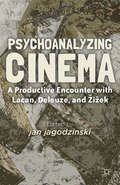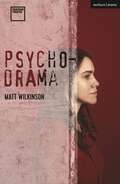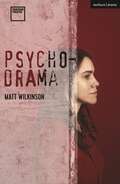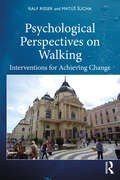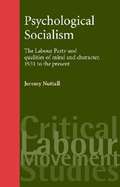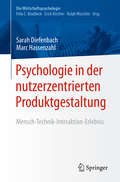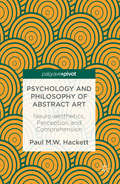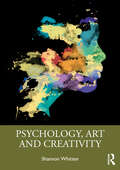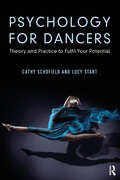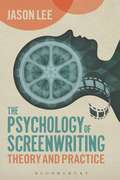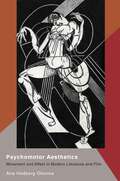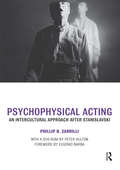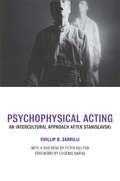- Table View
- List View
Psychoanalyzing Cinema: A Productive Encounter with Lacan, Deleuze, and Žižek
by Jan JagodzinskiThe essays within this collection explore the possibilities and potentialities of all three positions, presenting encounters that are, at times contradictory, at other times supportive, as well as complementary. The collection thereby enriches the questions that are being raised within contemporary cinematic studies.
Psychocinema (Theory Redux)
by Helen RollinsPsychocinema reexamines the connection between psychoanalysis and film, arguing for a return to the universalist core of both cinema and subjectivity. It traces the history of the influence of psychoanalysis on cinema and shows how the detour into ideologies of identity and difference eclipses the premise of the first and the emancipatory power of the second.The book argues that psychoanalysis does not simply help us elucidate what we see on screen: rather, there is a fundamental relationship between the structure of psychoanalysis and that of cinema. Cinema acts upon the viewer like psychoanalysis upon the analysand and can expose them to the universal Lack inherent in their desire. This process undermines the unconscious logic of capitalism, which relies on a promise in fulfilment.Rollins, a filmmaker, shows how reductive interpretations of psychoanalytic film theory have permeated film education and film practice and have affected the way films are made and watched, to the detriment of contemporary philosophy and politics. Psychocinema urges filmmakers, theorists and audiences to embrace the truly radical and emancipatory potential of cinema: its capacity to confront us with the universal Lack in our desire.
Psychodrama (Modern Plays)
by Matt WilkinsonDress by Ganni.Bra by Coco de Mer.Knife by Stanley.A gripping revenge tale about an actress in her 40s under investigation for the murder of an auteur theatre director whilst rehearsing a stage production of Hitchcock's Psycho.A whip-smart take on what it means to be middle-aged and female in an industry captivated by stardust and beauty.This edition was published to coincide with the run at The Traverse, Edinburgh, 2022.
Psychodrama (Modern Plays)
by Matt WilkinsonDress by Ganni.Bra by Coco de Mer.Knife by Stanley.A gripping revenge tale about an actress in her 40s under investigation for the murder of an auteur theatre director whilst rehearsing a stage production of Hitchcock's Psycho.A whip-smart take on what it means to be middle-aged and female in an industry captivated by stardust and beauty.This edition was published to coincide with the run at The Traverse, Edinburgh, 2022.
Psychodrama in Brazil: Contemporary Applications in Mental Health, Education, and Communities (Psychodrama in Counselling, Coaching and Education #3)
by Heloisa Junqueira Fleury Marlene Magnabosco Marra Oriana Holsbach HadlerThis book approaches contemporary psychodrama from many contexts and population application from different regions of Brazil. It presents the diversity of local culture, the originality with which psychodramatic philosophy emerges in the Brazilian scenario. It introduces the theoretical-methodological procedures that reaffirm psychodrama as a scientific instrument of social action. The chapters cover the philosophical and theoretical foundations and the new socio-psycho-educational methodologies applied in clinical practices, sociotherapy, politics and society. It is a helpful resource for professionals and academics interested in the development of innovative applications of Psychodrama.
Psychological Perspectives on Walking: Interventions for Achieving Change
by Ralf Risser Matúš ŠuchaPsychological Perspectives on Walking provides a comprehensive overview of the benefits of walking and shows how we can encourage people to walk more based on psychological principles. It examines how walking significantly improves health, positively impacts the environment, contributes to resolving social issues, and boosts the local micro-economy. This pioneering book discusses psychological motivations for walking versus not walking and asserts research-based arguments in favour of walking, including both theoretical considerations and everyday concerns. The book investigates the motivations that can lead to increased walking, advises on how to build walking-conducive habits, and recommends strategies for decision makers for promoting changes that will allow walking to thrive more easily. The authors include success stories and lessons learned from what have become known as 'walkable' cities to show how interventions and initiatives can succeed on a practical basis. This accessible, practical book is essential for urban planners; health specialists; policy makers; traffic experts; psychology, civil engineering, and social sciences students; and experts in the field of sustainable mobility. Psychological Perspectives on Walking will appeal to anyone in the general population in favour of a sustainable and healthy lifestyle.
Psychological Perspectives on Walking: Interventions for Achieving Change
by Ralf Risser Matúš ŠuchaPsychological Perspectives on Walking provides a comprehensive overview of the benefits of walking and shows how we can encourage people to walk more based on psychological principles. It examines how walking significantly improves health, positively impacts the environment, contributes to resolving social issues, and boosts the local micro-economy. This pioneering book discusses psychological motivations for walking versus not walking and asserts research-based arguments in favour of walking, including both theoretical considerations and everyday concerns. The book investigates the motivations that can lead to increased walking, advises on how to build walking-conducive habits, and recommends strategies for decision makers for promoting changes that will allow walking to thrive more easily. The authors include success stories and lessons learned from what have become known as 'walkable' cities to show how interventions and initiatives can succeed on a practical basis. This accessible, practical book is essential for urban planners; health specialists; policy makers; traffic experts; psychology, civil engineering, and social sciences students; and experts in the field of sustainable mobility. Psychological Perspectives on Walking will appeal to anyone in the general population in favour of a sustainable and healthy lifestyle.
Psychological socialism: The Labour Party and qualities of mind and character, 1931 to the present (Critical Labour Movement Studies)
by Jeremy NuttallTo Labour’s first Prime Minister, Ramsay MacDonald, socialism meant not only ‘satisfactory figures of death rates and …improved houses’ but also the ‘mental cleanliness, the moral robustness of our people.’ This book explores the neglected theme of individual character and ‘mental qualities’ in British social democratic thought and Labour Party history. How important was it for the centre-left that citizens be ‘good people’? What was the relationship between socialism and psychology in the 1930s? Did Labour’s technocratic, statist socialism of the 1950s and 1960s downgrade moral and mental progress? Why was the party often more concerned to produce a ‘rationally planned’ economy that rational, independent-minded citizens? Does New Labour represent a sidelining of ethical socialism or a re-birth of the pre-war left’s belief in improvement through education and self-control.
Psychologie in der nutzerzentrierten Produktgestaltung: Mensch-Technik-Interaktion-Erlebnis (Die Wirtschaftspsychologie)
by Sarah Diefenbach Marc HassenzahlDas informative und spannende Buch richtet sich an eine Leserschaft aus Praxis, Forschung und Lehre in der Psychologie, Gestaltung und Informatik. Anhand zahlreicher Beispiele zeigen die Autoren wie psychologisches Wissen gezielt für die erlebnis- und wohlbefindensorientierte Gestaltung interaktiver Produkte eingesetzt werden kann.Ob im Privaten oder auf der Arbeit: Interaktive Produkte, wie unsere Lieblingswebsites oder die Apps auf unseren Smartphones, müssen praktisch sein und Freude machen. Die Nutzung soll zum positiven Erlebnis werden (User Experience, UX). Um dieser Forderung gerecht zu werden, beschäftigen sich nun immer mehr Psychologen mit der menschengerechten Gestaltung interaktiver Produkte. Als User Experience Professionals oder Produktmanager arbeiten vielleicht auch Sie im interdisziplinären Team an der Nahtstelle von Design, angewandter Psychologie und Informatik.Im ersten Teil finden Sie Argumente, Positionen und aktuelle Forschungsergebnisse zum Thema "erlebnisorientierte Gestaltung", wie beispielsweise "Freude und Wohlbefinden als Gestaltungsziel" und "Ästhetik der Interaktion". Ein Arbeitsmodell soll dabei helfen, das Wissen im Gestaltungsalltag einzusetzen. Auch im zweiten Teils des Buches liegt der Fokus auf der praktischen Anwendung. Hier finden Sie Methoden und Werkzeuge für die psychologisch fundierte Gestaltung von Interaktion und Erlebnis. So bietet dieses Buch sowohl ein wissenschaftlich fundiertes wie auch anwendungsbezogenes Repertoire für die Gestaltung und Evaluation von Interaktion – damit interaktive Produkte unseren Alltag in Zukunft noch mehr bereichern.
Psychology and Philosophy of Abstract Art: Neuro-aesthetics, Perception and Comprehension
by Paul M.W. HackettThis book examines how we perceive and understand abstract art in contrast to artworks that represent reality. Philosophical, psychological and neuroscience research, including the work of philosopher Paul Crowther, are considered and out of these approaches a complex model is developed to account for this experience. The understanding embodied in this model is rooted in facet theory, mapping sentences and partially ordered analyses, which together provide a comprehensive understanding of the perceptual experience of abstract art.
Psychology, Art and Creativity
by Shannon WhittenThis comprehensive text challenges the taken-for-granted opposition of science and art by combining the fundamental principles of psychology, art and creativity and presenting the interdependent disciplines together in one unique, clear, and accessible resource. The author, Shannon Whitten, begins with an introduction to the foundations of art and psychology, providing readers with a critical understanding and history of the key concepts in both disciplines before establishing their interdependency. Drawing on a solid evidence base, the book then presents an assortment of extensive topics, from the human perception of color to the ability of art to impact mental health. The exploration of these topics enables the reader to reflect on the phenomenal power of human creativity. The chapters include vital categories of human psychology such as emotion, perception, personality, and social psychology to show the extensive connections between these elements of experience and art. Featuring a wealth of additional resources, this illuminating text equips the reader with a sound knowledge of the vocabulary and issues in the study of empirical aesthetics through visual content and stimulating prompts for reflection. Emphasizing the link between creativity and good mental health, the book is an essential read for students of the psychology of art, creativity, art therapy, and empirical aesthetics, as well as any discipline within the humanities, arts and science. It will also be of relevance to anyone interested in understanding the psychology behind creativity and its therapeutic effects on the artist.
Psychology, Art and Creativity
by Shannon WhittenThis comprehensive text challenges the taken-for-granted opposition of science and art by combining the fundamental principles of psychology, art and creativity and presenting the interdependent disciplines together in one unique, clear, and accessible resource. The author, Shannon Whitten, begins with an introduction to the foundations of art and psychology, providing readers with a critical understanding and history of the key concepts in both disciplines before establishing their interdependency. Drawing on a solid evidence base, the book then presents an assortment of extensive topics, from the human perception of color to the ability of art to impact mental health. The exploration of these topics enables the reader to reflect on the phenomenal power of human creativity. The chapters include vital categories of human psychology such as emotion, perception, personality, and social psychology to show the extensive connections between these elements of experience and art. Featuring a wealth of additional resources, this illuminating text equips the reader with a sound knowledge of the vocabulary and issues in the study of empirical aesthetics through visual content and stimulating prompts for reflection. Emphasizing the link between creativity and good mental health, the book is an essential read for students of the psychology of art, creativity, art therapy, and empirical aesthetics, as well as any discipline within the humanities, arts and science. It will also be of relevance to anyone interested in understanding the psychology behind creativity and its therapeutic effects on the artist.
Psychology for Dancers: Theory and Practice to Fulfil Your Potential
by Cathy Schofield Lucy StartPsychology for Dancers: Theory and Practice to Fulfil Your Potential examines how psychological theory can be related to dance practice. Aimed at the dancer who wants to maximize their potential but has no grounding in psychology, the book begins with an examination of basic psychological concepts, approaches and methods, before applying theory to dance. The book explores why dance is so important in many people’s lives: as a form of fitness, a profession, or visual entertainment. Each chapter then examines a different aspect of psychology related to dance in an applied context. Self-perception is examined as dancers are under great scrutiny; a grounded sense of self will ensure a positive perception of self-worth and body image, and suggestions are made as to how a healthy and motivational climate can be created. The book also places an emphasis on how cognitive skills are as important as technical skills, including the ability to learn and recall steps and choreography as efficiently as possible. Social factors are related to the dance context, with a discussion of effective leadership and communication skills and the importance of group cohesion. Finally, there is a review of the impact of emotions on dance practice and how best to manage these emotions. Each chapter reviews important psychological theories, offering practical suggestions on how they can be applied to dance practice. Psychology for Dancers is an invaluable resource for students, professionals, and teachers of dance.
Psychology for Dancers: Theory and Practice to Fulfil Your Potential
by Cathy Schofield Lucy StartPsychology for Dancers: Theory and Practice to Fulfil Your Potential examines how psychological theory can be related to dance practice. Aimed at the dancer who wants to maximize their potential but has no grounding in psychology, the book begins with an examination of basic psychological concepts, approaches and methods, before applying theory to dance. The book explores why dance is so important in many people’s lives: as a form of fitness, a profession, or visual entertainment. Each chapter then examines a different aspect of psychology related to dance in an applied context. Self-perception is examined as dancers are under great scrutiny; a grounded sense of self will ensure a positive perception of self-worth and body image, and suggestions are made as to how a healthy and motivational climate can be created. The book also places an emphasis on how cognitive skills are as important as technical skills, including the ability to learn and recall steps and choreography as efficiently as possible. Social factors are related to the dance context, with a discussion of effective leadership and communication skills and the importance of group cohesion. Finally, there is a review of the impact of emotions on dance practice and how best to manage these emotions. Each chapter reviews important psychological theories, offering practical suggestions on how they can be applied to dance practice. Psychology for Dancers is an invaluable resource for students, professionals, and teachers of dance.
The Psychology of Screenwriting: Theory and Practice
by Jason LeeThe Psychology of Screenwriting is more than an interesting book on the theory and practice of screenwriting. It is also a philosophical analysis of predetermination and freewill in the context of writing and human life in our mediated world of technology. Drawing on humanism, existentialism, Buddhism, postmodernism and transhumanism, and diverse thinkers from Meister Eckhart to Friedrich Nietzsche, Theodor Adorno, Jacques Derrida, Jean Baudrillard and Gilles Deleuze, The Psychology of Screenwriting will be of use to screenwriters, film students, philosophers and all those interested in contemporary theory. This book combines in-depth critical and cultural analysis with an elaboration on practice in an innovative fashion. It explores how people, such as those in the Dogme 95 movement, have tried to overcome traditional screenwriting, looking in detail at the psychology of writing and the practicalities of how to write well for the screen. This is the first book to include high-theory with screenwriting practice whilst incorporating the Enneagram for character development. Numerous filmmakers and writers, including David Lynch, Jim Jarmusch, David Cronenberg, Pedro Almodóvar, Darren Aronofsky, Sally Potter and Charlie Kaufman are explored. The Psychology of Screenwriting is invaluable for those who want to delve deeper into writingfor the screen.
The Psychology of Screenwriting: Theory and Practice
by Jason LeeThe Psychology of Screenwriting is more than an interesting book on the theory and practice of screenwriting. It is also a philosophical analysis of predetermination and freewill in the context of writing and human life in our mediated world of technology. Drawing on humanism, existentialism, Buddhism, postmodernism and transhumanism, and diverse thinkers from Meister Eckhart to Friedrich Nietzsche, Theodor Adorno, Jacques Derrida, Jean Baudrillard and Gilles Deleuze, The Psychology of Screenwriting will be of use to screenwriters, film students, philosophers and all those interested in contemporary theory. This book combines in-depth critical and cultural analysis with an elaboration on practice in an innovative fashion. It explores how people, such as those in the Dogme 95 movement, have tried to overcome traditional screenwriting, looking in detail at the psychology of writing and the practicalities of how to write well for the screen. This is the first book to include high-theory with screenwriting practice whilst incorporating the Enneagram for character development. Numerous filmmakers and writers, including David Lynch, Jim Jarmusch, David Cronenberg, Pedro Almodóvar, Darren Aronofsky, Sally Potter and Charlie Kaufman are explored. The Psychology of Screenwriting is invaluable for those who want to delve deeper into writingfor the screen.
The Psychology of Teaching and Learning Music
by Edward R. McClellanThe Psychology of Teaching and Learning Music introduces readers to the key theoretical principles, concepts, and research findings about learning and how these concepts and principles can be applied in the music classroom. Beginning with an overview of the study of teaching and learning, and moving through applying theory to practice, and reflective practice in the process of personal growth, this text focuses on music learning theories, behavioral approaches, cognitive, social-cognitive development, and constructive views of learning. It includes culture and community, learning differences, motivation, effective curricular design, assessment, and how to create learning environments, illustrated by practical case studies, projects, exercises, and photos. Showing students how to apply the psychology theory and research in practice as music educators, this book provides a valuable resource for undergraduate and graduate music education students and faculty.
The Psychology of Teaching and Learning Music
by Edward R. McClellanThe Psychology of Teaching and Learning Music introduces readers to the key theoretical principles, concepts, and research findings about learning and how these concepts and principles can be applied in the music classroom. Beginning with an overview of the study of teaching and learning, and moving through applying theory to practice, and reflective practice in the process of personal growth, this text focuses on music learning theories, behavioral approaches, cognitive, social-cognitive development, and constructive views of learning. It includes culture and community, learning differences, motivation, effective curricular design, assessment, and how to create learning environments, illustrated by practical case studies, projects, exercises, and photos. Showing students how to apply the psychology theory and research in practice as music educators, this book provides a valuable resource for undergraduate and graduate music education students and faculty.
The Psychology of the Selfie: What the Research Says
by Barrie GunterThe Psychology of the Selfie provides a comprehensive overview and analysis of research on the significance of selfies, offering insights into the topic from a psychological perspective and examining important issues such as body image, self-objectification, mental health and psychological benefits. Selfies are a worldwide phenomenon. Although dismissed by critics as a sign of self-absorbed narcissism, they are also a social currency that maintains and reinforces friendships, a feedback loop for self-identity affirmation, a promotional tool for gaining social influence, and a method for preserving memories of life events. In this book, Barrie Gunter expertly explores the psychological underpinnings of the contemporary global phenomenon of "selfies", from the historical roots and meteoric rise due to technical advancements, to the different personality types of selfie-takers, to social relationships, to group and personal identity. Looking at both the psychological nature and impact of selfies, this book reviews different psychological outcomes for selfie-takers, both positive and negative, and the growth in psychological and physical problems that can sometimes arise. Presenting a comprehensive analysis specifically of selfie behaviour, this book is an essential reference for students and researchers in communications and media, journalism, information studies, psychology and sociology, as well as anyone with a general interest in the phenomenon.
The Psychology of the Selfie: What the Research Says
by Barrie GunterThe Psychology of the Selfie provides a comprehensive overview and analysis of research on the significance of selfies, offering insights into the topic from a psychological perspective and examining important issues such as body image, self-objectification, mental health and psychological benefits. Selfies are a worldwide phenomenon. Although dismissed by critics as a sign of self-absorbed narcissism, they are also a social currency that maintains and reinforces friendships, a feedback loop for self-identity affirmation, a promotional tool for gaining social influence, and a method for preserving memories of life events. In this book, Barrie Gunter expertly explores the psychological underpinnings of the contemporary global phenomenon of "selfies", from the historical roots and meteoric rise due to technical advancements, to the different personality types of selfie-takers, to social relationships, to group and personal identity. Looking at both the psychological nature and impact of selfies, this book reviews different psychological outcomes for selfie-takers, both positive and negative, and the growth in psychological and physical problems that can sometimes arise. Presenting a comprehensive analysis specifically of selfie behaviour, this book is an essential reference for students and researchers in communications and media, journalism, information studies, psychology and sociology, as well as anyone with a general interest in the phenomenon.
Psychomotor Aesthetics: Movement and Affect in Modern Literature and Film
by Ana Hedberg OleninaIn the late 19th century, modern psychology emerged as a discipline, shaking off metaphysical notions of the soul in favor of a more scientific, neurophysiological concept of the mind. Laboratories began to introduce instruments and procedures which examined bodily markers of psychological experiences, like muscle contractions and changes in vital signs. Along with these changes in the scientific realm came a newfound interest in physiological psychology within the arts - particularly with the new perception of artwork as stimuli, able to induce specific affective experiences. In Psychomotor Aesthetics, author Ana Hedberg Olenina explores the effects of physiological psychology on art at the turn of the 20th century. The book explores its influence on not only art scholars and theorists, wishing to understand the relationship between artistic experience and the internal processes of the mind, but also cultural producers more widely. Actors incorporated psychology into their film acting techniques, the Russian and American film industries started to evaluate audience members' physical reactions, and literary scholars began investigations into poets' and performers' articulation. Yet also looming over this newly emergent field were commercial advertisers and politicians, eager to use psychology to further their own mass appeal and assert control over audiences. Drawing from archival documents and a variety of cross-disciplinary sources, Psychomotor Aesthetics calls attention to the cultural resonance of theories behind emotional and cognitive experience - theories with implications for today's neuroaesthetics and neuromarketing.
PSYCHOMOTOR AESTHETICS C: Movement and Affect in Modern Literature and Film
by Ana Hedberg OleninaIn the late 19th century, modern psychology emerged as a discipline, shaking off metaphysical notions of the soul in favor of a more scientific, neurophysiological concept of the mind. Laboratories began to introduce instruments and procedures which examined bodily markers of psychological experiences, like muscle contractions and changes in vital signs. Along with these changes in the scientific realm came a newfound interest in physiological psychology within the arts - particularly with the new perception of artwork as stimuli, able to induce specific affective experiences. In Psychomotor Aesthetics, author Ana Hedberg Olenina explores the effects of physiological psychology on art at the turn of the 20th century. The book explores its influence on not only art scholars and theorists, wishing to understand the relationship between artistic experience and the internal processes of the mind, but also cultural producers more widely. Actors incorporated psychology into their film acting techniques, the Russian and American film industries started to evaluate audience members' physical reactions, and literary scholars began investigations into poets' and performers' articulation. Yet also looming over this newly emergent field were commercial advertisers and politicians, eager to use psychology to further their own mass appeal and assert control over audiences. Drawing from archival documents and a variety of cross-disciplinary sources, Psychomotor Aesthetics calls attention to the cultural resonance of theories behind emotional and cognitive experience - theories with implications for today's neuroaesthetics and neuromarketing.
Psychophysical Acting: An Intercultural Approach after Stanislavski
by Phillip B. ZarrilliPsychophysical Acting is a direct and vital address to the demands of contemporary theatre on today’s actor. Drawing on over thirty years of intercultural experience, Phillip Zarrilli aims to equip actors with practical and conceptual tools with which to approach their work. Areas of focus include: an historical overview of a psychophysical approach to acting from Stanislavski to the present acting as an ‘energetics’ of performance, applied to a wide range of playwrights: Samuel Beckett, Martin Crimp, Sarah Kane, Kaite O’Reilly and Ota Shogo a system of training though yoga and Asian martial arts that heightens sensory awareness, dynamic energy, and in which body and mind become one practical application of training principles to improvisation exercises. Psychophysical Acting is accompanied by Peter Hulton’s interactive DVD-ROM featuring exercises, production documentation, interviews, and reflection.
Psychophysical Acting: An Intercultural Approach after Stanislavski
by Phillip B. ZarrilliPsychophysical Acting is a direct and vital address to the demands of contemporary theatre on today’s actor. Drawing on over thirty years of intercultural experience, Phillip Zarrilli aims to equip actors with practical and conceptual tools with which to approach their work. Areas of focus include: an historical overview of a psychophysical approach to acting from Stanislavski to the present acting as an ‘energetics’ of performance, applied to a wide range of playwrights: Samuel Beckett, Martin Crimp, Sarah Kane, Kaite O’Reilly and Ota Shogo a system of training though yoga and Asian martial arts that heightens sensory awareness, dynamic energy, and in which body and mind become one practical application of training principles to improvisation exercises. Psychophysical Acting is accompanied by Peter Hulton’s interactive DVD-ROM featuring exercises, production documentation, interviews, and reflection.
The Psychopolitics of Fashion: Conflict and Courage Under the Current State of Fashion
by Otto Von BuschWhat if fashion was a state? What kind of state would it be? Probably not a democracy. Otto von Busch sees fashion as a totalitarian state, with a population all too eager to enact the decrees of its aesthetic superiority. Peers police each other and deploy acts of judgment, peer-regulation, and micro-violence to uphold the aesthetic order of fashion supremacy. Using four design projects as tools for inquiry, Von Busch explores the seductive desires of envy and violence within fashion drawing on political theories. He proposes that the violent conflicts of fashion happen not only in arid cotton fields or collapsing factories, but in the everyday practice of getting dressed, in the judgments, sneers, and rejections of others. Indeed, he suggests that feelings of inclusion and adoration are what make us feel the pleasure of being fashionable-of being seductive, popular, and powerful. Exploring the conflicting emotions associated with fashion, Von Busch argues that while the current state of fashion is bred out of fear, The Psychopolitics of Fashion can offer constructive modes of mitigation and resistance. Through projects that actively work towards disarming the violent practices of dress, Von Busch suggests paths towards a more engaging and meaningful experience of fashion he calls “deep fashion.”
